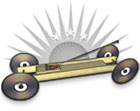Mouse Trap Vehicle: Activities
Earth shattering secrets for building record setting and winning mousetrap cars and racers. Here you will find all the latest and greatest untold construction secrets so you can build your very own mousetrap vehicle.
Understanding Lever Arms
In this activity students will build a basic mousetrap powered vehicle and then measure both it's travel distance and speed. Between trials, students adjust the length of the mousetrap's lever arm, reposition the mousetrap, and then again re-measure both it's travel distance and speed. Students will then graph the results for each lever arm length in order to discover the relationship between lever arm length and distance of travel, and speed.
Analyzing Motion
In Chasing the Mouse students will analyze and graph the motion of a mousetrap powered vehicle over 5 meters. Students will collect data from their mousetrap car using a ticker timer. A ticker timer is a device that makes marks on a ticker tape at equal intervals of time. From the data they collection, students will make several graphs that show the velocity and acceleration of their mousetrap racer over a five meter distance.
Finding Rolling Friction
Students will calculate the bearing friction acting against their mousetrap car. Friction is a force that acts against the motion of all moving objects. A moving mousetrap car is affected by two type of friction: air-friction and bearing friction. Air-friction is only a large factor with fast moving mousetrap cars and is nearly negligible for slow-moving distance travelers; therefore, in this lab students will only look at bearing friction.
Finding Wheel Traction
Students will calculate the amount of "grip" or traction their mousetrap car's wheels have on the floor. The more "grip" or traction a mousetrap car's wheels have on the floor means the greater the acceleration that is possible. Knowing the amount of traction can help builders maximize acceleration.
Starting Energy / Spring Constant
In All Wound Up, students will find and calculate the starting potential energy of their mousetrap and they will also find their mousetrap's spring coefficient. All spring obey Hooke's law and understanding this easy concept we can find both the strength of the mousetrap's spring and how much energy is stored in the mousetrap's spring when fully wound-up.
Finding Total Friction
This is an easy way to find the force of friction acting against a mousetrap vehicle. This lab requires that a student has already done the All Wound Up activity and/or knows the starting energy of their mousetrap. In this activity, students measure how far their mousetrap car travels and then use the starting energy to solve for the work done or the force of friction.
Maximum Pulling Distance
This is an easy-to-do activity for all ages. In this activity students will calculate the maximum pulling distance for their mousetrap car and will also find their mousetrap vehicle's mechanical advantage. The pulling distance is the measurement from where the vehicle starts to when the pulling force of the string ends. Once students have a predicted pulling distance they will measure and time the actual pulling distance in order to calculate the power output.
*Can't find what you’re looking for? Ask Doc Fizzix »




